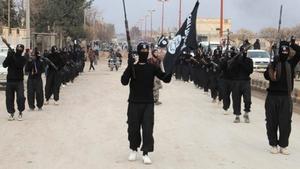ISISISIS has sufficient quantities of arms to carry on fighting for two years: UN
A new report prepared for the United Nations Security Council warns that Islamic State (ISIS) has in its possession sufficient reserves of small arms, ammunition, and vehicles to wage its war for Syria and Iraq for up to two years. The size and diversity the Islamist organization’s arsenal allow the group durable mobility, range, and a limited defense against low-flying aircraft. The report notes that even if the U.S.-led air campaign continues to destroy the group’s vehicles and heavier weapon systems, such a campaign “cannot mitigate the effect of the significant volume of light weapons” Isis possesses.

ISUS has a substantial amount of supplies and ordinance // Source: alarabalyawm.net
A new report prepared for the United Nations Security Council warns that Islamic State (ISIS) has in its possession sufficient reserves of small arms, ammunition, and vehicles to wage its war for Syria and Iraq for up to two years.
The size and diversity the Islamist organization’s arsenal allow the group durable mobility, range, and a limited defense against low-flying aircraft. The report notes that even if the U.S.-led air campaign continues to destroy the group’s vehicles and heavier weapon systems, such a campaign “cannot mitigate the effect of the significant volume of light weapons” Isis possesses.
These weapons “are sufficient to allow [ISIS] to continue fighting at current levels for six months to two years,” the UN report finds, describing ISIS not only the world’s best-funded terrorist group but among its best armed.
The UN report concludes that ISIS, together with the Nusra Front, ISIS former rival but now its tactical ally, are sufficiently equipped to threaten the region “even without territory.”
The Guardian notes that the 35-paqge report recommends the UN implement new steps to cut off ISIS access to money and guns.
The ISIS arsenal, according to the UN assessment, includes T-55 and T-72 tanks; U.S.-manufactured Humvees; machine guns; short-range anti-aircraft artillery, including shoulder-mounted rockets captured from Iraqi and Syrian military stocks; and “extensive supplies of ammunition.”
Most the ISIS weapons stocks, particularly “state of the art” weaponry stolen from the U.S.-backed Iraqi military, were “unused” before ISIS fighters seized it, the report finds. Some of the relatively complex weapons, however, “may be too much of a challenge” for ISIS effectively use or maintain.
The Guardian notes that earlier this year, speculation focused on ISIS potential ability to produce chemical weapons after it seized Iraqi facilities that had contributed to Saddam Hussein’s chemical weapons programs, but the UN report says it is doubtful that ISIS possesses the “capability fully to exploit material it might have seized.” The UN report also questions whether ISIS can manufacture its own chemical or other weapons of mass destruction.
The intelligence services of one member state involved in contributing to the report provided information about “chemicals and poison-coated metal balls” placed inside ISIS homemade bombs to maximize damage. In October, Kurdish forces defending the Syrian town of Kobani from ISIS complained of skin blistering, burning eyes, and difficulty breathing after the detonation of an ISIS bomb – all symptoms of chemical weapon use.
The UN Security Council is will begin consideration of the report today (Wednesday).
The report recommends the UN adopt new round of sanctions aiming to disrupt the economic well-being of the well-financed ISIS. A major element of these sanctions would be for states bordering ISIS-controlled territory to “promptly seize all oil tanker trucks and their loads” coming in or going out.
The report warns that ISIS has several revenue sources, and it does not assert that oil truck seizures can eliminate ISIS oil smuggling money, it does say that raising the costs to smuggling networks and trucking companies will deter them from bringing ISIS oil to market.
The report also says that it is important to disrupt ISIS ability to resupply its weapons stocks and launder money, and the report recommends the UN prohibit any aircraft originating from ISIS-held territory from landing on airstrips in member states, and prohibit flights into ISIS-held territory. The only exemptions would involve humanitarian relief planes.
Last month, a report to the Security Council on ISIS manpower, assessed that 15,000 fighters from eighty countries have arrived in Syria and Iraq to fight ISIS ranks.
— Read more in The Islamic State in Iraq and the Levant and the Al-Nusrah Front for the People of the Levant: report and recommendations submitted pursuant to resolution 2170 (United Nations Security Council, 14 November 2014)
